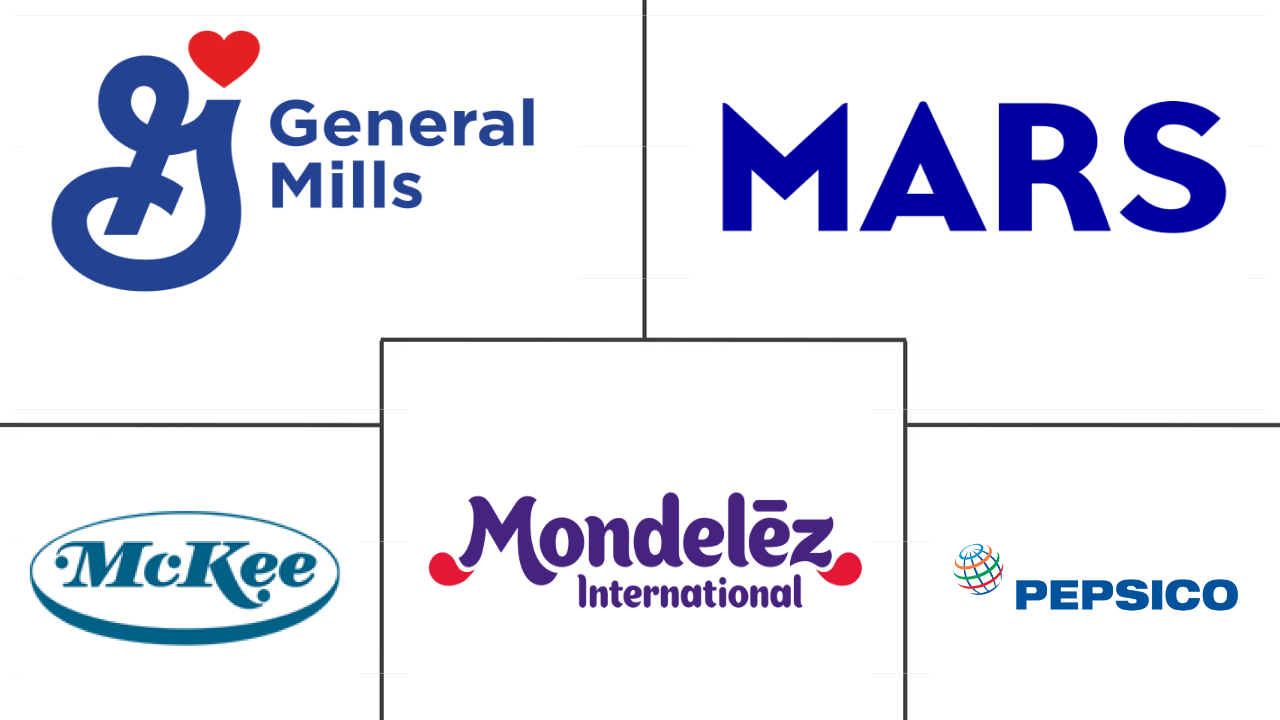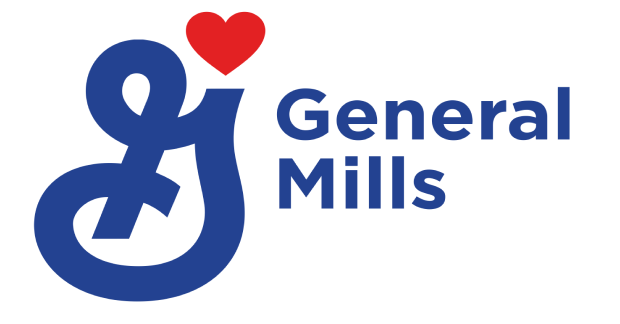Market Size of north america cereal bar Industry
|
|
Study Period | 2018 - 2030 |
|
|
Market Size (2024) | USD 5.85 Billion |
|
|
Market Size (2030) | USD 8.31 Billion |
|
|
Largest Share by Distribution Channel | Supermarket/Hypermarket |
|
|
CAGR (2024 - 2030) | 6.04 % |
|
|
Largest Share by Country | United States |
Major Players |
||

|
||
|
*Disclaimer: Major Players sorted in no particular order |
North America Cereal Bar Market Analysis
The North America Cereal Bar Market size is estimated at 5.85 billion USD in 2024, and is expected to reach 8.31 billion USD by 2030, growing at a CAGR of 6.04% during the forecast period (2024-2030).
5.85 Billion
Market Size in 2024 (USD)
8.31 Billion
Market Size in 2030 (USD)
5.13 %
CAGR (2018-2023)
6.04 %
CAGR (2024-2030)
Largest Segment by Distribution Channel
40.26 %
value share, Supermarket/Hypermarket, 2023
Supermarkets and hypermarkets offer confectioneries under various labels, like clean-label and free-form products, which give consumers choices according to their preferences.
Largest Segment by Country
77.23 %
value share, United States, 2023
The change in consumer preferences as they seek health-promoting and convenient products to satisfy hunger by replacing a meal is driving the market in the United States.
Fastest-growing Segment by Distribution Channel
7.08 %
Projected CAGR, Online Retail Store, 2024-2030
The ease of shopping experience and availability of many products and the increasing number of retailers in this channel have become a major driver of the segment's growth.
Fastest-growing Segment by Country
8.75 %
Projected CAGR, Mexico, 2024-2030
The increased nutritional value of cereal bars with intense health benefits, such as reducing cholesterol levels, is anticipated to drive the segment's growth in Mexico.
Leading Market Player
14.17 %
market share, General Mills Inc., 2022

General Mills Inc. has gained a competitive edge due to its extensive product portfolio and wide brand presence, along with its strategic moves toward innovation.
Supermarkets/hypermarkets and convenience stores accounted for major shares of sales of cereal bars due to easy accessibility coupled with the provided discounts
- The sales of cereal bars in supermarkets and hypermarkets grew by 14% in the region from 2022 to 2024, owing to the easy availability of cereal bars among these retail channels. Supermarkets and hypermarkets remain the leading channels for these sales. From 2019 to 2023, the sales of cereal bars across supermarkets and hypermarkets grew by 23% in volume. Consumer preference for these channels is driven by seasonal offers, discounts on bulk purchases, and access to diversified brand and product varieties in a single marketplace. Supermarket chains such as Safeway, Walmart, Costco, Amazon Fresh, Target, Whole Foods, Publix, and Aldi have a dedicated section to showcase cereal bars.
- After supermarkets and hypermarkets, convenience stores are the second most widely preferred distribution channel for purchasing cereal bars in the region. The segment had a 28% share of overall sales through off-trade channels in 2022. The broader reach and easy access to private label brands drive the consumer preference for traditional grocery stores over other retail channels. The cereal bars sales value through convenience stores is estimated to register a CAGR of 5.82% from 2023-2029 to reach a sales value of USD 2224.79 million in 2029.
- The online channel is projected to be the fastest-growing distribution channel for cereal bars, with an anticipated CAGR of 6.90% in terms of value during 2023-2029. The evolving role of online channels in grocery purchases is influenced by the vast population in the country having internet access. In 2022, 93.4% of the population in the region have accessed the internet. The leading online retailers that offer cereal bars are Walmart, Amazon, Dell, Sears, Costco, and Best Buy.
The United States dominates the market with growing consumer preference toward ready-to-eat products, supporting the sales of cereal bars
- The North American cereal bars market has observed a growth of 15% from 2021-2023. The growth is attributed to consumer preference toward cereal-based ready-to-eat (RTE), meal replacement, and packed food items. Cereal, including cereal bars, is the nation’s number one choice for breakfast. 14% of the US population preferred it as their favorite breakfast option in 2023. The sales of cereal bars in North America are anticipated to grow by 19% during 2024-2027.
- By country, the United States is a leading market for cereal bar consumption in the region. It is anticipated that the sales value will increase by 23% in 2024 compared to 2021. As of 2023, more than 90% of consumers in the United States stated that they are consuming snacks, including cereal bars. Cereal bars are the largest-growing segment in the country, with an estimated value growth of 7% in 2023 relative to 2022. They are promoted as a portable and handy breakfast or snack choice.
- Canada is also one of the leading countries consuming cereal bars in the North American region. Consumers believe a cereal-based diet rich in carbohydrates, fiber, and nuts improves blood pressure and lowers cholesterol. The growth is aided by the growing demand for clean-label products and the rising awareness of healthy food. Canadians are increasingly consuming cereal bars with nutrient-rich, gluten-free, sugar-free varieties. Some popular brands offering sugar-free, organic cereal bars in Canada include Made Good, GoGo Quinoa, Nature's Path, Nii Bar, and True Nature. The sales of cereal bars in Canada are anticipated to grow by a value of 15% during 2024-2027.
North America Cereal Bar Industry Segmentation North America Cereal Bar Industry Segmentation
Convenience Store, Online Retail Store, Supermarket/Hypermarket, Others are covered as segments by Distribution Channel. Canada, Mexico, United States are covered as segments by Country.
- The sales of cereal bars in supermarkets and hypermarkets grew by 14% in the region from 2022 to 2024, owing to the easy availability of cereal bars among these retail channels. Supermarkets and hypermarkets remain the leading channels for these sales. From 2019 to 2023, the sales of cereal bars across supermarkets and hypermarkets grew by 23% in volume. Consumer preference for these channels is driven by seasonal offers, discounts on bulk purchases, and access to diversified brand and product varieties in a single marketplace. Supermarket chains such as Safeway, Walmart, Costco, Amazon Fresh, Target, Whole Foods, Publix, and Aldi have a dedicated section to showcase cereal bars.
- After supermarkets and hypermarkets, convenience stores are the second most widely preferred distribution channel for purchasing cereal bars in the region. The segment had a 28% share of overall sales through off-trade channels in 2022. The broader reach and easy access to private label brands drive the consumer preference for traditional grocery stores over other retail channels. The cereal bars sales value through convenience stores is estimated to register a CAGR of 5.82% from 2023-2029 to reach a sales value of USD 2224.79 million in 2029.
- The online channel is projected to be the fastest-growing distribution channel for cereal bars, with an anticipated CAGR of 6.90% in terms of value during 2023-2029. The evolving role of online channels in grocery purchases is influenced by the vast population in the country having internet access. In 2022, 93.4% of the population in the region have accessed the internet. The leading online retailers that offer cereal bars are Walmart, Amazon, Dell, Sears, Costco, and Best Buy.
| Distribution Channel | |
| Convenience Store | |
| Online Retail Store | |
| Supermarket/Hypermarket | |
| Others |
| Country | |
| Canada | |
| Mexico | |
| United States | |
| Rest of North America |
North America Cereal Bar Market Size Summary
The North American cereal bar market is experiencing significant growth, driven by increasing consumer demand for convenient and nutritious snack options. Supermarkets and hypermarkets are the primary distribution channels, offering a wide variety of brands and products, which attract consumers through seasonal offers and bulk purchase discounts. Convenience stores also play a crucial role, providing easy access to private label brands. However, the online channel is emerging as the fastest-growing distribution method, fueled by the high internet penetration in the region. This shift towards online shopping is supported by major retailers like Walmart and Amazon, which offer a diverse range of cereal bars to cater to the evolving consumer preferences.
In terms of market dynamics, the United States leads in cereal bar consumption, with a significant portion of the population incorporating them as a staple breakfast or snack option. Canada also shows a strong preference for cereal bars, particularly those that are nutrient-rich and align with the growing demand for clean-label products. The market is characterized by a fragmented landscape, with key players such as General Mills, Mars, and PepsiCo holding substantial shares. The focus on health and nutrition continues to drive innovation and product development, as manufacturers respond to the rising consumer interest in healthier snack alternatives.
North America Cereal Bar Market Size - Table of Contents
-
1. MARKET SEGMENTATION (includes market size in Value in USD and Volume, Forecasts up to 2030 and analysis of growth prospects)
-
1.1 Distribution Channel
-
1.1.1 Convenience Store
-
1.1.2 Online Retail Store
-
1.1.3 Supermarket/Hypermarket
-
1.1.4 Others
-
-
1.2 Country
-
1.2.1 Canada
-
1.2.2 Mexico
-
1.2.3 United States
-
1.2.4 Rest of North America
-
-
North America Cereal Bar Market Size FAQs
How big is the North America Cereal Bar Market?
The North America Cereal Bar Market size is expected to reach USD 5.85 billion in 2024 and grow at a CAGR of 6.04% to reach USD 8.31 billion by 2030.
What is the current North America Cereal Bar Market size?
In 2024, the North America Cereal Bar Market size is expected to reach USD 5.85 billion.

